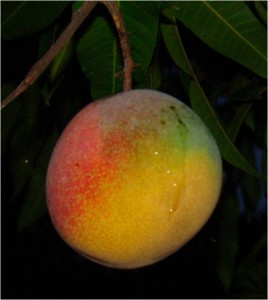Hayden Mango
Originating in Florida and cultivated since 1910 the true Hayden variety of mango is a well known, traditional favorite among tropical and subtropical growers. Despite being fibrous and prone to fungus it has a good flavor often considered well worth the draw backs of below average disease resistance and is prone to “jelly seed” condition. As far as mangos go, the Hayden variety is one of the most cold tolerant and does well in most soils. It is a vigorous, large grower and grafted trees will usually hold fruit by their fifth year.

| Name | Mangifera indica |
| Hardiness Zones | 9-11 mature trees tolerant to 25 degrees |
| Flower Color | Long clusters of small white to pink flowers |
| Blooms | Spring |
| Light Needs | Full Sun |
| Water Needs | Moderate water |
| Soil Needs | Moist, Well-Drained |
| Fruits | Summer |
Care information
The Hayden mango is relatively easy to care for thanks to its high tolerance of even poor soils. Moderate watering during dry periods may be required. The susceptibility to various fungi may require the use of commonly available fungicides although this is less a problem with individual fruit trees. While mature trees are cold tolerant to 25 degrees, young ones may die if exposed to 29-30 degrees, so, special attention should be paid in winter. Since the Hayden mango is a large tree often growing over 20ft in height, care should be taken not to plant it too close to other trees. Windy areas should also be avoided until the tree matures. Plant the tree in a location with full sun exposure and fertilize as needed.
Design Ideas
The Hayden Mango is a large tree that will add a tropical look to any terrain. It grows to enormous proportions if left alone but can usually be trimmed to 15ft with little effect on fruit setting. It has a large open canopy that tends to be ovular in shape making it an ideal shade tree, and its long clusters of pinkish white flowers are sure to captivate onlookers from late May to June. The fruit that follows is large and roundish to an oval in shape, weighing 6-24oz. They will start off green, ripening to a golden yellow with red highlights and a pinkish blush. The brightly colored ornamental fruit is well set across its backdrop of deep tropical greens making this tree an attractive tropical delight for any landscape.





